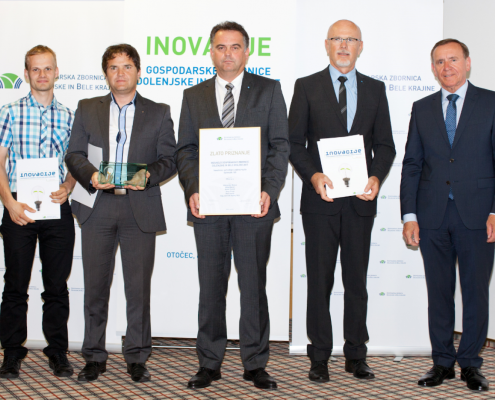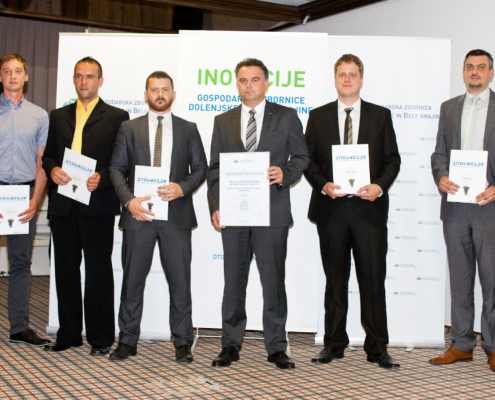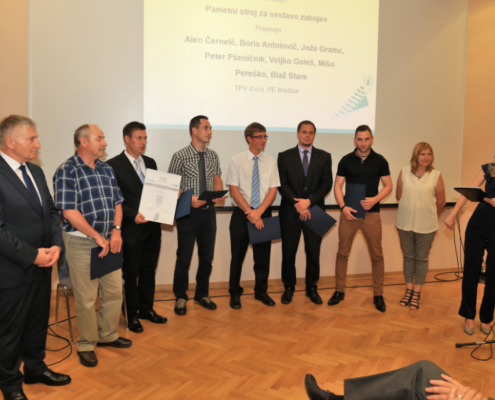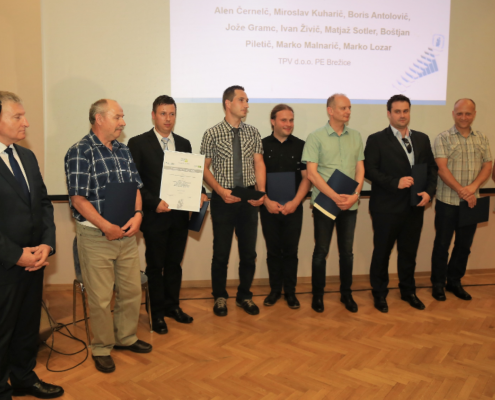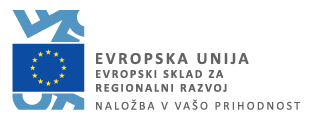Innovativeness promoted by TPV Group again confirmed with 7 awards for innovations
Innovations are one of key factors having a significant impact on the company’s performance which is also acknowledged by TPV Group. Their innovations are recognized by both their customers, who are offering them increasingly complex development projects, and professionals. Last week, they were given seven awards for innovation;
Gold award for innovation conferred by the Chamber of Commerce and Industry of Dolenjska and Bela Krajina (GZDBK) for:
- Innovative automated guided vehicle Optimatik 160
Authors: Janez Sluga, Dominik Rajšelj, M.Sc., Robert Simčič, Aleksander Brence, Aleš Ucman, Matej Mikolič, Matjaž Sotler
3 silver awards for innovations GZDBK for:
- Development of dynamically loaded friction coupling joint of the shift mechanism
Authors: Vili Malnarič, M.Sc. , Jurij Švegelj, Janez Hočevar, Matija Požgaj, Silvester Urek - Implementation of collaborative robots
Authors: Toni Kambič, Boštjan Piletič, Mišo Pereško, Nenad Rađenović, Matej Kozan and Jure Filak - Along with the Faculty of Industrial Engineering Novo mesto we received a silver award for the innovation called 3D scanning and making of a 3D model based on a point cloud as a step in reverse engineering process of a trailing arm.
Authors: Davor Tramte, B.S.M.E. at FINI, mentor at TPV: Vili Malnarič, M.Sc., mentor at FINI: Tomaž Savšek, Assist. Prof., Ph. D., TPV
2 silver awards conferred by the Regional Chamber of the region for the innovation called:
- Smart cardboard box assembly machine
Authors: Alen Černelč, Boris Antolovič, Jože Gramc, Peter Pšeničnik, Veljko Goleš, Mišo Pereško, Blaž Stare - Automated electric resistance welding machine with servo positioner and rotary table
Authors: Alen Černelč, Miroslav Kuharič, Boris Antolovič, Jože Gramc, Ivan Živič, Matjaž Sotler, Boštjan Piletič, Marko Malnarič, Marko Lozar
Gold medal granted at the innovation exposition iKA in Karlovac for:
- Innovative automated guided vehicle Optimatik 160
Authors: Janez Sluga, Dominik Rajšelj. M.Sc., Robert Simčič, Aleksander Brence, Aleš Ucman, Matej Mikolič, Matjaž Sotler.
The innovations rewarded reflect innovativeness in the field of autonomous systems, product development, process optimisation and implementation of new technologies. Not only their quality has been recognized by the expert committee, but all innovations rewarded have already been implemented at the customers or in our work processes.
Descriptions od innovations:
Innovative automated guided vehicle Optimatik 160
Authors: Janez Sluga, Dominik Rajšelj, M.Sc., Robert Simčič, Aleksander Brence, Aleš Ucman, Matej Mikolič, Matjaž Sotler
Automation of internal logistics using automated guided vehicles, AGVs, is important to increase efficiency and reduce production costs, and therefore represents a significant factor in automating production sites and warehouses. AGV is a transport vehicle with a possibility of automatic control. Complexity of the solution is built on a software controlling the AGVs and connecting them to their environment. The TPV concept is based on the company’s own modular and open source central control system. Development of software solutions is the result of cooperation with the development partner, IKU. The TPV approach of logistics process automation is built on two principles. The first principle is the technological knowledge of logistics processes and the second the knowledge related to the automation of such processes. They both ensure that the customers’ needs are understood in the course of the professional interaction with the customer leading to effective and reliable solutions. They have realized that trolley conversion to a bigger height (usually necessary with competitors’ AGVs) constitutes a substantial obstacle in implementing automation of internal logistics using AGVs. Consequently, they developed their own automated guided vehicle called Optimatik 160 which is unique on the market. Its essential advantage lies in its low height. Optimatik 160 is even lower than the standard industrial trolley wheels resulting in no need to convert the trolleys in use. Another advantage is their small width of 420 mm enabling transport of standard EURO pallets without any need of trolley conversion.
Development of dynamically loaded friction coupling joint of the shift mechanism
Authors: Vili Malnarič, M.Sc., Jurij Švegelj, Janez Hočevar, Matija Požgaj, Silvester Urek
Shift rod is considered an important part of the shift mechanism as it is connected to the joint through the movable coupling joint. The mechanism has to allow a smooth gear shift and also reduce gear lever vibrations. The movable coupling joint is usually used with a bolt made of steel and on both sides backed with a washer and secured with a split pin preventing the bolt to slide out of the groove. In order to reduce weight, a request was made to make all shift mechanism parts of aluminium, while the bolt needs to be secured against sliding only with friction due to lack of space. For the mechanism production, the press-in technology is used for the bolt which goes through the groove inside the joint and then through the groove inside the rod where it functions as a bearing, and at the other end it goes again through the groove inside the joint.
For the process of bolt press-in we defined force and velocity of bolt press-in using experimental development. Despite following all requirements, a problem occurred as the bolts started to get out of the groove after the gear box had been in use for some time. Owing to the nature of assembly, it was, from technology point of view, impossible to ensure press-in parallelism which led to a situation with the highest force needed at the beginning and decreased force at the end of press-in. To perform the function of keeping the bolt within the groove, this should be the opposite way around with the press-in force being the highest at the end. As a consequence, the bolt often blocked during press-in which stopped the process. Should the groove hole increase due to the force, the press-in force shall decrease. In the first case, the defect is immediately apparent. In the other case, a hidden defect occurs and after the gear box has been in use for some time, the bolt may slide out of the groove resulting in a serious failure of shift mechanism.
By doing numerous analyses and tests we developed an efficient lubrication system and an appropriate lubricant to press-in the bolt. In order to facilitate the press-in, we also developed an innovative shape or geometry of the bolt along with an affordable technology for bolt manufacturing. Using an innovative method we reduced the bolt diameter on the part which is first pressed into the groove and therefore enabled a parralel guidance at the press-in.
The innovative geometry of the bolt along with the innovative lubrication method have resulted in a better force application during the press-in so that the highest force is applied at the end of the press-in process. This allows a good hold of the bolt in the groove and an increased dynamic strength of the coupling joint. We have also significantly eliminated the problem of tribocorrosion fatigue and reached a better smoothness in the area of the movable coupling joint.
The whole process is automated and provides a high series production with a 100 % control of all key steps and parameters. Due to the bolt innovative design and new press-in technology, the scrap has been reduced from 20 % to less than 0,1 % which represents significant savings on material, energy and time.
Implementation of collaborative robots in workplaces
Authors: Toni Kambič, Boštjan Piletič, Mišo Pereško, Nenad Rađenović, Matej Kozan and Jure Filak
So far, the industrial robots have been used in the same workplace almost throughout their lifetime and robotisation hasn’t been efficient and useful in small batches. In classical robotic application, the process was built around the robotic workplace, which required an appropriate process adjustment and integration of robotisation already at the stage of process design as subsequent upgrading was no longer possible or even much too costly.
Aiming toward continuous improvements, we have changed this thinking. We have stepped out of established patterns and through an innovative approach, and by means of collaborative robots, we have robotized the existing processes and those whose applications were not suitable for classical robots. The innovation resulted in improvement in terms of :
- productivity,
- quality,
- ergonomics,
- safety,
- costs,
- internal logistics,
- and environmental impacts.
We have used the advantage of collaborative robots and by means of two mobile robots developped different applications. This has given a new perspective on using robots in the process of sheet metal forming and implementing such solutions in other processes.
3D scanning and making of a 3D model based on a point cloud as a step in reverse engineering process of a trailing arm.
Authors: Davor Tramte, B.S.M.E. at FINI, mentor at TPV: Vili Malnarič, M.Sc., mentor at FINI: Tomaž Savšek, Assist. Prof., Ph. D., TPV
This innovation has increased the efficiency of product development process by using reverse engineering enabling 3D modelling of the existing solution. We use the 3D model to make finite element analysis contributing significantly to a better understanding of the loading issue of the component and to creation of ideas for new design solutions. We can carry out development activities even before we receive the official request for quotation from the customer, which is a time-saving feature compared to competitors. With the innovative use of the existing software by adjusting the analysis process to the hardware capacities we have decreased the development costs and accelerated the product development process.
Smart cardboard box assembly machine – Authors: Alen Černelč, Boris Antolovič, Jože Gramc, Peter Pšeničnik, Veljko Goleš, Mišo Pereško, Blaž Stare
Machine for assembly of cardboard boxes type EXO 2.0 KLT 6147 provides an automated assembly and handling of cardboard boxes used for final product packaging. The automated assembly of non-returnable packaging has resulted in better productivity and reduction in storage space which had been used for storage of cardboard boxes. The machine is user-friendly and provides an automatic operation and communication with users. The system includes a control over the volume of boxes needed for smooth operation. The control over the position of the box components made by the detector enhances process realibility and quality.
Automated electric resistance welding machine with servo positioner and rotary table – Authors: Alen Černelč, Miroslav Kuharič, Boris Antolovič, Jože Gramc, Ivan Živič, Matjaž Sotler, Boštjan Piletič, Marko Malnarič, Marko Lozar
Automated electric resistance welding machine with servo positioner and rotary table with infinite rotation is an innovation in the area of automation as it provides a complete control over product and process parameters of the welding cycle for different types of products. The operator can simultaneously make 4 types of related products while the machine automatically identifies the product, its position and orientation, as well as parameters related to different types of products, e.g. the electrode force, welding current and welding time. The machine provides an automatic ejection of the welded parts from the weld nest which relieves the operator whose task is to insert the components and remove only good welded parts ejected by the machine.

